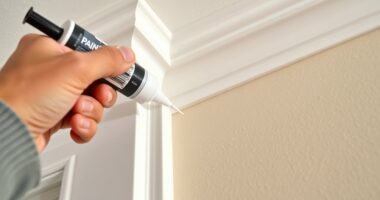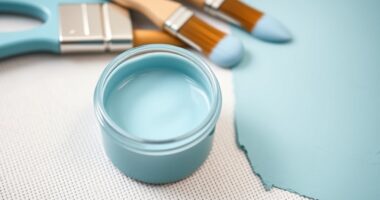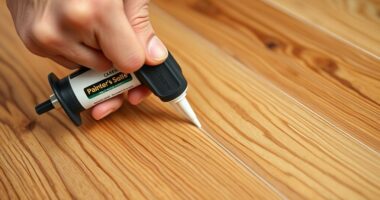To achieve authentic antique finishes with milk paint, start by properly preparing your surface for better adhesion and aging effects. Use gentle distressing techniques like light sanding on edges and raised areas to reveal underlying layers and mimic natural wear. Experiment with color mixing to create subtle variations that add depth. Combining these methods helps you craft a genuine vintage look that highlights character and charm, and if you keep exploring, you’ll discover even more tips for perfecting your finish.
Key Takeaways
- Use milk paint powders to customize colors and achieve layered, aged effects for a genuine antique look.
- Properly prepare surfaces with sanding and cleaning to ensure durability and authentic distressing outcomes.
- Apply thin coats of milk paint, allowing each layer to dry, then mix and blend colors for depth and complexity.
- Use gentle distressing techniques like sanding edges and corners to mimic natural wear and weathered surfaces.
- Incorporate tools like steel wool or wire brushes after drying to enhance the vintage, weathered appearance.

Have you ever wondered how to achieve a beautiful, natural finish on your furniture or home decor? If so, milk paint is an excellent choice. Its unique qualities give your pieces an authentic, vintage look that’s hard to replicate with modern paints. But to get that perfect antique finish, you need to master a few essential techniques, especially distressing and color mixing. These methods allow you to create a truly aged appearance that feels both intentional and timeless.
Distressing techniques are key to transforming fresh milk paint into a piece that looks genuinely old. Once you’ve applied the paint and it has dried, you can start distressing to reveal layers underneath or to soften the overall look. Sanding is your go-to method—using fine-grit sandpaper, gently rub certain areas to reveal the wood or previous paint layers. Focus on edges, corners, and raised surfaces, as these naturally wear over time. You can also use other tools like steel wool or a wire brush to add texture, giving your furniture a more authentic aged effect. The goal is to make the piece look like it’s been through years of use, not artificially distressed. Don’t be afraid to experiment with different techniques until you find the right balance that suits your style. Incorporating proper surface preparation can also enhance the durability of your finish and improve how it ages naturally over time.
Color mixing plays a pivotal role in achieving the desired vintage look with milk paint. Unlike conventional paints, milk paint is usually sold in powders that you mix with water, giving you the flexibility to adjust the hue and opacity. Start by testing small batches to see how different color mixes behave. You can blend multiple colors to create subtle variations, mimicking the natural aging process of paint over time. For example, mixing a hint of gray or blue into your base color can add depth and complexity, making your finish more realistic. Don’t shy away from experimenting with tinting powders, which can deepen or lighten your mixture. Remember, a little goes a long way, and patience is key—you can always add more pigment if needed. When you combine thoughtful color mixing with your distressing techniques, your furniture will achieve an authentic, antique appearance that looks both beautiful and lived-in.
Frequently Asked Questions
Can Milk Paint Be Used on Outdoor Furniture?
Yes, you can use milk paint on outdoor furniture, but you need to guarantee it stands up to weather resistance. Proper prep techniques, like cleaning the surface thoroughly and applying a primer, help the paint adhere well. Sealing with a good outdoor topcoat is essential for durability. With these steps, your furniture will maintain its charm and withstand the elements for years to come.
How Long Does Milk Paint Typically Last?
You might wonder how long milk paint lasts, balancing its charming aging process against paint durability. Typically, milk paint can last 5 to 10 years outdoors, but exposure to weather accelerates the aging process, giving your furniture a rustic, authentic look. Indoor use extends its lifespan even further. Keep in mind, proper sealing can enhance durability, helping your piece maintain its character over time.
Is Milk Paint Suitable for Kitchen Cabinets?
You can definitely use milk paint for kitchen cabinets if you’re into furniture restoration with a focus on historical accuracy. It offers a charming, authentic finish that’s perfect for recreating vintage looks. Keep in mind, milk paint isn’t as durable as modern finishes, so you’ll want to seal it properly. With proper care, your cabinets will maintain their rustic charm and authentic appeal for years to come.
What Tools Are Best for Applying Milk Paint?
Did you know that using the right tools can make your milk paint look more authentic? For applying milk paint, brush techniques and applicator types matter. You should pick natural-bristle brushes for a smooth finish or stencils for texture. A foam roller works for even coats, while a dry brush creates a distressed effect. Experiment with these tools to achieve the perfect vintage look on your furniture.
Can Milk Paint Be Mixed With Other Finishes?
You can definitely mix milk paint with other finishes, but you should consider color mixing and finish compatibility first. When combining it with stains or clear wax, verify they won’t alter the milk paint’s unique matte look. Test small batches to see how the finishes interact, as some might affect adhesion or texture. This way, you can create custom shades and achieve the desired antique effect while maintaining durability.
Conclusion
Now that you’ve learned the secrets of milk paint, you’re like a painter holding a weathered brush, ready to breathe life into old surfaces. Every stroke you make is a whisper of history, each finish a story waiting to be told. Embrace the imperfections—they’re the fingerprints of authenticity. With patience and passion, your furniture becomes a treasured relic, a timeless whisper of the past, echoing the beauty of imperfection and the charm of genuine age.









